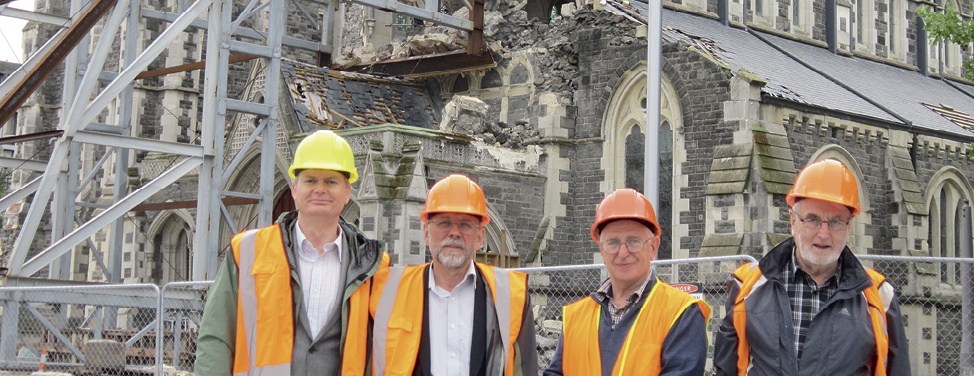Opinion: Prevention is no longer a useful term in emergency management
Stuart Ellis
Stuart Ellis AM says resilience is a fine example of the right term conveying the right message.
Article
Stuart Ellis is a consultant in emergency management who has worked in the industry for the last 15 years. He was Chief Officer of the South Australia Country Fire Service from 1996-2002. While this article was written prior to the announcement, Stuart Ellis is the incoming CEO of the Australasian Fire and Emergency Service Authorities Council, with his appointment commencing on 26 November 2012.

Image: Stuart Ellis
Review Team members Stuart Ellis, Basil Wakelin, David Oughton, and Ian McLean (Chair). The Review is currently being considered by the New Zealand Government.
Having been a team member that recently completed a review of the operational response to the Christchurch Earthquake in New Zealand, it reinforced to me the inappropriate use of the term prevention when referring to natural disasters. Prevention is cited as an aspect of emergency management referred to as the ‘Comprehensive Approach’ in our national doctrine, being “the development of emergency and disaster arrangements to embrace the aspects of prevention, preparedness, response, and recovery (PPRR).”1
While our doctrine acknowledges it is not a series of sequential phases,2 the doctrine also ignores the reality that PPRR is out-dated.
Apart from using an inappropriate term which I shall return to, our doctrine ignores the role of research, even though Cooperative Research Centres have been established and other research is being conducted which is well acknowledged as enhancing emergency management capability and performance. This was explored by the COAG National Inquiry into Bushfire Mitigation and Management 2004 which proposed the 5 R’s:3
- Research, information and analysis
- Risk modification
- Readiness
- Response
- Recovery
Referring back to Christchurch, even the 5 R’s proposed in 2004 do not take account of the necessary role emergency managers have in influencing the ‘reconstruction’ phase (for both communities and infrastructure), to ensure they have greater resilience – an ongoing activity in Christchurch today. Reconstruction goes beyond recovery. You may recover from a bout of illness and resume your normal life, but after a major disaster, there is a need to reconstruct, do things differently and better, not recover what you had before. In all likelihood, that will no longer be possible. Reconstruction is for a further ‘R’ that could be added to the 2004 COAG Report’s 5 R’s.

Image: Stuart Ellis
A unit block being ‘deconstructed’ after the earthquake albeit it remained standing during the event.
Why is the use of terminology important? Because we know the public pays scant attention to our emergency management messages at any time, and promoting terms such as prevention may generate an expectation in the minds of the public that despite whatever nature delivers, emergency managers can prevent it becoming a disaster. For natural disasters that are likely to impact our region, the use of the term is flawed at worse and unhelpful at best. We cannot prevent an earthquake, subsequent tsunami, cyclone, hail storm, or bushfire and the list goes on. Prescribed burning is likely to reduce the intensity of bushfires in areas that have been treated, but that is the best we can hope for and arguably on a Catastrophic-Code Red day, that treatment will provide little, if any, substantive mitigation.
Fortunately the Australian Government is focussing on ‘Resilience’ (a further R, or perhaps the centre of what should be an updated ‘Comprehensive Approach’), rather than prevention, with its National Strategy for Disaster Resilience.4 Hopefully State and Territory-based agencies will follow similar approaches. Bushfire prevention plans and programs should be rebadged. They should be referred to as ‘Risk Reduction’ plans and programs – reflecting more accurately what they are seeking to achieve.
In Christchurch after February 2011 resilience was very apparent – resilience of the vast majority of structures, of communities, and of attitudes. Of course none of these remained unchanged. A resilient building may need to be deconstructed and rebuilt, but if it remained upstanding and allowed its occupants to escape, it was resilient. Likewise with communities. They will adjust and refocus but they are largely surviving. Resilience is a fine example of the right term conveying the right message.
So let’s do away with the term prevention in regard to emergency management. Even in our doctrine, we are saying prevention means something else: “regulatory and physical measures to ensure that emergencies are prevented, or their effects mitigated”.5 If prevention means mitigation it is nonsensical.
Our national strategy states: “Natural disasters are a feature of the Australian climate and landscape and this threat will continue, not least because climate change is making weather patterns less predictable and more extreme.”6 We know we have limited opportunity to communicate with the public regarding our needs and their obligations to ensure the impact of future natural disasters is minimised. We know that effective communication and example on the ground is going to best convey our message. We should not persist using words that we say also mean something else and that convey to the public an unrealistic expectation regarding our capabilities and the impact of natural events. It is time to remove prevention from our emergency management lexicon and rethink what a truly comprehensive approach should look like.
Footnotes
1. Australian Emergency Management Series.
2. Australian Emergency Management Series.
3. Ellis, Kanowski, Whelan, COAG National Inquiry on Bushfire Mitigation and Management 2004 p52.
4. National Strategy for Disaster Resilience 2009.
5. Australian Emergency Management Series.
6. COAG National Disaster Resilience Statement, 7 December 2009.


